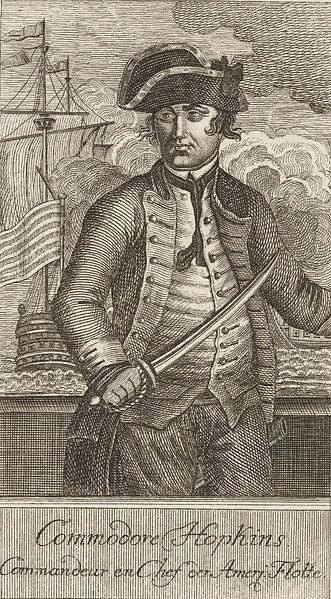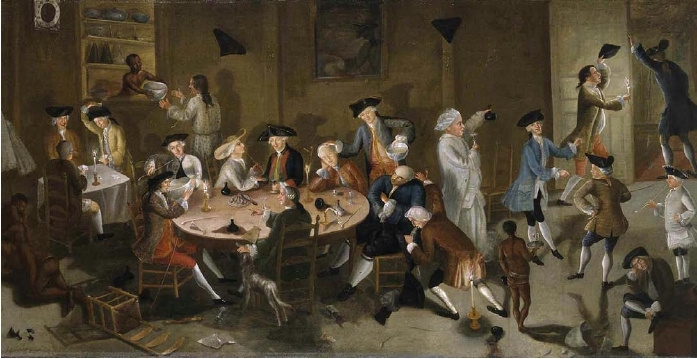<Back to Index>
- Geologist Christian Leopold von Buch, 1774
- Painter Gian Paolo Lomazzo, 1538
- Commander in Chief of the Continental Navy Esek Hopkins, 1718
PAGE SPONSOR

Esek Hopkins (April 26, 1718 – February 26, 1802) was a Commander in Chief of the Continental Navy during the American Revolutionary War.
Esek Hopkins was born in Scituate, Rhode Island. Before the Revolutionary War he had sailed to nearly every quarter of the earth, commanded a privateer in the French and Indian War, and served as a deputy to the Rhode Island General Assembly. Appointed a brigadier general to command all the colony's military forces October 4, 1775, he immediately began to strengthen Rhode Island's defenses with the help of his deputy, William West. A few months later, December 22, 1775, Hopkins was appointed Commander in Chief of the Continental Navy authorized by the Continental Congress to protect American commerce. He also was a founding member of the Society of the Cincinnati.
In
September 1764, during his time as a privateer and merchant, Hopkins
took command of the slave ship the Sally owned by Nicholas Brown and
Company. Hopkins
had no prior experience in operating a slave trading vessel at the
time, and the 15 month voyage would result in disaster with 109 out of
196 slaves dying after being acquired. In late 1765, the Sally arrived
at its first trading destination in the West Indies,
but the surviving African captives were in such poor health that most
sold for very little. Hopkins' failed command of the Sally contributed
to the Brown brothers reconsidering their participation in the active
slave trade of Rhode Island in the 18th century. On
January 5, 1776, Congress gave Hopkins his second set of orders. "You
are instructed with the utmost diligence to proceed with the said fleet
to sea and if the winds and weather will possibly admit of it to
proceed directly for Chesapeake Bay in Virginia and when nearly arrived
there you will send forward a small swift sailing vessel to gain
intelligence.... If... you find that they are not greatly superior to
your own you are immediately to enter the said bay, search out and
attack, take or destroy all the naval force of our enemies that you may
find there. If you should be so fortunate as to execute this business
successfully in Virginia you are then to proceed immediately to the
southward and make yourself master of such forces as the enemy may have
both in North and South Carolina... Notwithstanding these particular
orders, which it is hoped you will be able to execute, if bad winds, or
stormy weather, or any other unforeseen accident or disaster disable
you so to do, You are then to follow such Courses as your best Judgment
shall suggest to you as most useful to the American Cause and to
distress the Enemy by all means in your power." Hopkins took command of eight small merchant ships that had been altered as men of war at Philadelphia.
By taking advantage of the loop hole in the second set of orders, Esek
Hopkins sailed south February 17, 1776 for the first U.S. Fleet
operation that took the fleet to Nassau in the Bahamas. The Battle of Nassau, an assault on the British colony there March 3, 1776 was also the first U.S. amphibious landing. Marines and
sailors landed in "a bold stroke, worthy of an older and better trained
service," capturing munitions desperately needed in the War of
Independence. The little fleet returned to New London on April 8, 1776, having also made prizes of two British merchantmen and a six-gun schooner, but failing to capture the HMS Glasgow on April 6. John Hancock,
President of the Continental Congress, wrote Hopkins: "I beg leave to
congratulate you on the success of your Expedition. Your account of the
spirit and bravery shown by the men affords them [Congress] the
greatest satisfaction . . ." However
on August 12, 1776, Hopkins was censured by Congress. Humiliation and a
destroyed reputation followed after the censure. Many sources say it
would have been better if Hopkins was relieved of his command after the
censure, rather than resume his command with a disgraced reputation and
a lost respect from his officers. Hopkins' little fleet was mostly blockaded in Narragansett Bay by
the superior British seapower for the rest of Hopkins' tenure as
Commander-in-Chief of the Continental Navy. As time progressed,
pressure on the nature of Hopkins' character and ability became
increasingly significant. Hopkins had disregarded his second set of
Congressional orders directing him to rid the Chesapeake of British
cruisers, instead raiding New Providence. This was compounded by
allegations of inaction such as the failure to capture HMS Glasgow on the return voyage from Nassau. Because of the continuing debacle, on 2
January 1778, Hopkins was relieved of his command permanently. Esek
Hopkins continued to serve the Rhode Island General Assembly through
1786, then retired to his farm where he died February 26, 1802. His
home, the Esek Hopkins House, is now listed on the National Register of Historic Places.
Hopkins was the brother of Rhode Island governor Stephen Hopkins, a signer of the Declaration of Independence. Hopkins' daughter, Susanna Hopkins, became the wife of Jonathan Maxcy, a Baptist minister and second president of the formerly Baptist affiliated Brown University which was then known as the College of Rhode Island and Providence Plantations.
